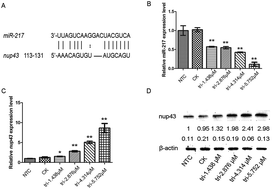Triazophos-induced toxicity in zebrafish: miRNA-217 inhibits nup43
Abstract
Triazophos is a highly toxic organophosphorus pesticide, causing acute toxicity to brain tissue, and neurotoxicity and embryotoxicity to animals. Therefore, triazophos is considered as a public health problem due to its acute hazard index. MicroRNAs (miRNAs), a class of endogenous noncoding RNAs, can regulate the expression of target gene(s) by mediating mRNA cleavage or translational repression in organisms exposed to environmental chemicals. We found that nup43 is targeted by miR-217, which was significantly regulated in adult zebrafish (Danio rerio) exposed to triazophos (phenyl-1,2,4-triazolyl-3-(o,o-diethyl thionophosphate)). The expression of nup43 in both mRNA and protein levels was downregulated in a dose-dependent manner upon stimulation with triazophos. A dual luciferase reporter assay demonstrated that miR-217 interacted with the 3′-untranslated regions (3′-UTR) of nup43. The expression of nup43 in both mRNA and protein level was reduced in ZF4 cells when transfected with an miR-217 mimic, but increased when transfected with an miR-217 inhibitor. As a result, nup43 is targeted by miR-217 upon triazophos exposure. We suggest that miR-217 could be a potential toxicological biomarker for triazophos.



 Please wait while we load your content...
Please wait while we load your content...